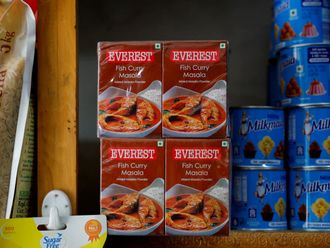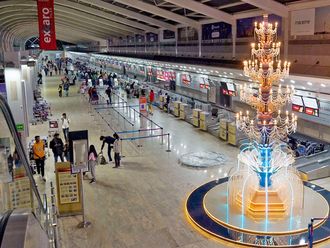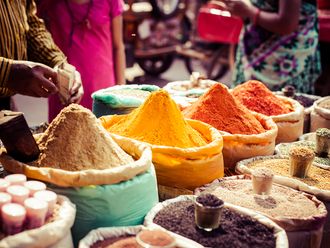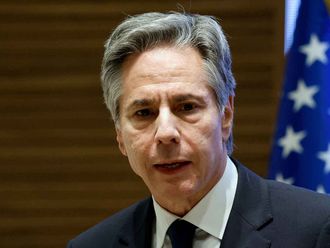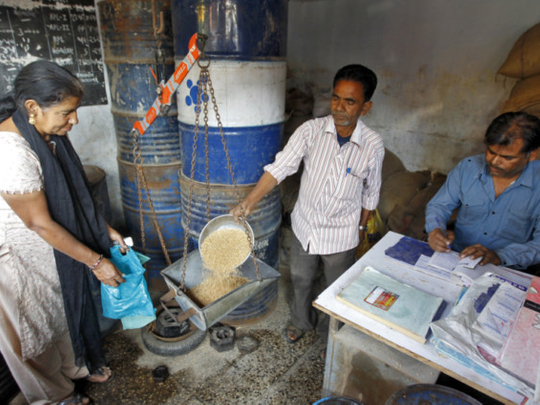
NEW DELHI: Mohanlal Kapoor, a street vendor in north India, holds a card entitling him to subsidized food for his wife and four children. To get supplies, the Kapoors must battle an estimated 15 million families in their state toting similar pieces of paper that they’re not entitled to.
“When I go to the ration store, I only receive enough to feed half my family,” Kapoor said, frying samosas and bright- orange sweets in a wok-shaped karhai pan to earn about $3 a day in Vrindavan, a city about halfway between New Delhi and the Taj Mahal. “They tell me I came too late and all the food is gone, but everyone around here knows it’s being sold in markets for profit.”
To curb such abuses, which can add as much as 60 percent to what the government spends on wheat, grain and sugar, India is trying a new solution. In the past year, ration cards such as Kapoor’s laminated piece of paper with a glued-on or photocopied passport photo are being replaced with smartcards that hold biodata and can track food doled out in the world’s biggest distribution system for the poor.
Working on a state-by-state basis, the National Informatics Centre is spending 42 billion rupees ($684 million) over three years on computerized systems to monitor food from when the government buys it at the farm gate until it reaches the intended targets.
“We’re pushing this digitized system as hard as we can,” said Ranjna Nagpal, the centre’s deputy director general. “Without it, the rest of the country’s efforts to save public distribution will be fruitless.”
Almost 60 percent of the more than $14 billion India plans to spend on wheat, rice and sugar for the poor this year is likely to go missing, if World Bank estimates prove accurate.
Politically connected gangs siphon off food to sell for profit - in Kapoor’s state of Uttar Pradesh alone, as much as $14.5 billion was stolen between 2002 and 2012, Bloomberg News reported last year. Or else it rots in the open because warehouses can’t contain the bulging stockpiles fattened each harvest by India’s bumper crops.
Against this backdrop of theft and waste, more than three- quarters of India’s population eats less than the minimum targets set by the government, and the nation is home to one in three of the world’s malnourished children. About 5,000 Indian children aged 5 or younger die every day because of their poor diets, according to UNICEF.
“The most important challenge in solving India’s malnutrition problem is ensuring supply,” Michael Jensen, country director of the United Nations’ World Food Programme, said in an interview at his New Delhi office. “Technology can certainly help to get rid of fake ration cards.”
About 1,300 miles south of Kapoor’s hometown, the former French enclave of Pondicherry that was the setting for Ang Lee’s 2012 movie “Life of Pi” is among the first six regions turning to technology to improve oversight. The government has recorded the fingerprints of Pondicherry’s almost 1 million people as part of a digitized system to track every welfare transaction, along with each truck, barrel and sack of food distributed to 370 subsidy stores and the territory’s residents.
The tracking makes it harder for ration-store owners to game the system by selling their subsidized grains to anyone other than the holder of a digital card, said Gopi Swaminathan, head of the National Informatics Centre’s local branch.
When Murugesan, a 60-year-old construction worker with one name, goes to his neighborhood ration shop, he inserts his card into a reader linked to a statewide database that documents the transaction and checks his entitlements. His purchases are tracked in his online profile, which includes his family’s eligibility for subsidized food and kerosene, each member’s name, age, gender, occupation and income, along with their pictures and scans of their left thumb print.
“These simple technological solutions have saved millions of tons of food from being sold into the black market,” said S. Anburaj, senior assistant to Pondicherry’s public-private cooperative, which manages many of the territory’s discount supply stores.
Electronic tracking is also being tried in the central state of Odisha, where the World Food Programme has collected fingerprints and iris scans of the 1 million people in Rayagada district to set up a system with 3M Co. Tata Consultancy Services Ltd. has joined forces with northern Haryana state, which is preparing to issue smartcards to 25 million people, and global positioning systems are used in parts of Tamil Nadu to track trucks carrying food from storage facilities.
State initiatives complement efforts by the publicly funded Unique Identification Authority, led by Infosys Ltd. co-founder Nandan Nilekani, who quit India’s second-biggest software exporter for the mission to assign a unique ID number to all 1.23 billion Indians.
The national government has already invested $550 million on the program. One proposed extension of the system is to replace subsidized food and kerosene with cash transferred directly into the bank accounts of beneficiaries to use as they see fit, Nilekani said in an interview.
“Technology and systems will certainly help fill in the gaps that are hindering India’s food supply from reaching the mouths of the malnourished,” he said. “But the ultimate responsibility will fall on the shoulders of local stakeholders like discount shops, teachers, parents or beneficiaries.”
The plan faces hurdles. On Sept. 23, India’s Supreme Court ruled that ID cards can’t be made mandatory, in part because many Indians lack the documentation to prove their identities.
There are also concerns over whether government funds will be spent wisely and the possibility that a database of ID numbers for every Indian could be manipulated to commit identity theft or voting fraud, said V. Suresh, a Chennai-based attorney in Tamil Nadu and an adviser to the Supreme Court on food security.
“Governance and accountability has to improve,” Suresh said at his office outside the High Court in Chennai, Tamil Nadu’s capital. “All this technology can’t save India from poor execution of its systems.”
The state of 66 million people started its own program five years ago that hasn’t moved beyond the pilot stage and is about to be folded into a National Informatics Centre initiative, said M.P. Nirmala, the Tamil Nadu food secretary.
Even so, she denied there was a malnutrition problem.
“Our systems are working and making things better,” Nirmala said. “There is no supply problem. Anyone who wants to buy food or eat for free has that option.”
While the state is “recognized for performing well in the areas of child survival and social development” about a third of children younger than 3 are still considered underweight, and child malnutrition and neonatal mortality remain “major concerns,” according to UNICEF, the U.N.’s children fund.
In Uttar Pradesh, where poverty is on par with sub-Saharan Africa, about 35 percent of the state’s 44 million ration cards are held by ineligible people who bribe crooked bureaucrats to get them, said Ram Kumar, head of the Dynamic Action Group, a local human-rights organization. Nationwide, the objective for many is to manipulate the government’s welfare programs, whether it’s for food, water, kerosene or power, Kumar said.
Written proof that Kapoor is even entitled to receive food aid is almost untraceable, stacked along with the millions of other ration-card registrations at the state’s food ministry.
To confirm his allowance, Kapoor would depend on some of the same politicians and bureaucrats who pocket much of the 100 billion-rupee annual budget to feed India’s poorest and most- populous state, according to the August 2012 investigation by Bloomberg News.
The card “doesn’t mean anything if the supplies aren’t reaching this place,” Kapoor said. “Then who do I complain to? The people in charge are the ones looting us.”
At the discount store where Kapoor collects his food, the owner keeps a paper register that he agrees is impossible to authenticate. An electronic point-of-sale device provided by the state government sits on a ledge beside a boarded-up window, the unconnected power cords dangling uselessly. The shop doesn’t get reliable enough electricity to keep the unit charged, the owner said.
The Uttar Pradesh state government has doled out these point-of-sale devices to many of its 766 discount supply stores - one shop for every 57,000 ration card holders. The state has been slow to provide the National Informatics Centre the data it needs to complete a network like Pondicherry’s and issue smartcards, said Nagpal, the centre’s deputy director general.
Uttar Pradesh’s top official overseeing food, Deepak Trivedi, didn’t reply to emails, faxes and phone calls seeking comment on the state’s public distribution program. Jiwesh Nandan, head of the technology department, said his officials were in the process of providing NIC with information for a database, without saying when it would be available.
Raja Bhaiya, who as food minister presided over Uttar Pradesh’s distribution system, has cases pending against him for attempted murder, kidnapping, armed robbery and electoral fraud under his formal name, Raghuraj Pratap Singh, according to the legal declaration candidates must make to the election commission. He hasn’t been convicted and has denied the charges and involvement in the food scam.
After being forced to step down in March over allegations his party was behind the murder of a policeman, Bhaiya was last month reappointed as food minister. Calls to his office went unanswered.
As Kapoor’s 12-year-old son, Chhottu, pushes their food cart home at the end of a day that earned $1 less than India’s $4.20 average income, he said he worries about the boy’s future.
“Nothing’s got better in my lifetime” he said. “Unless they bring an end to all this corruption, he’s probably going to end up living the same miserable kind of life as I’ve had.”


